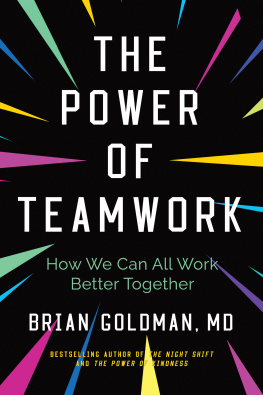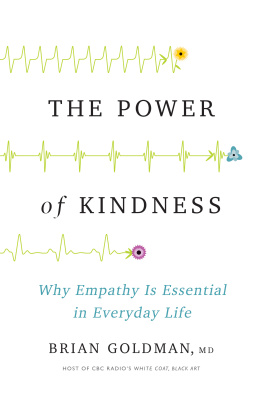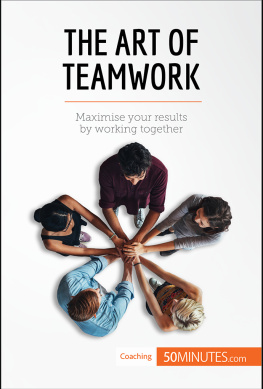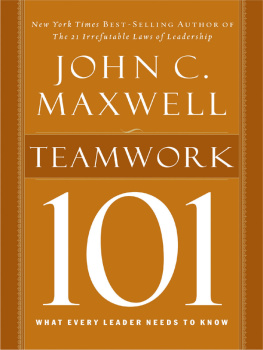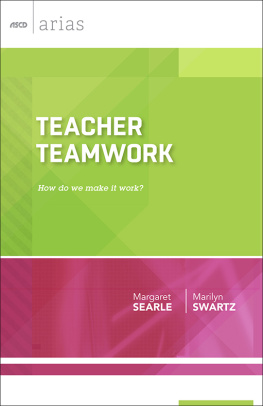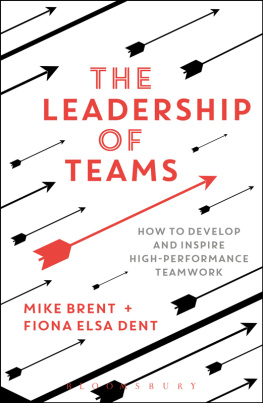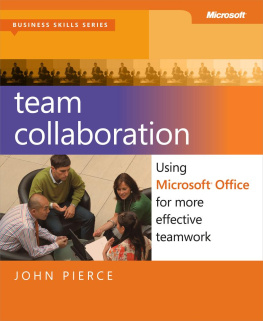Contents
Guide
To Elaine Bromiley, whose tragic story inspired me to write this book
Contents
D O YOU WORK on a team? For most of us, thats as banal a question as youll get.
People in all walks of life talk about the importance of teamwork. In sports, its the difference between winning and losing. At Fortune 500 companies, teamwork builds trust and fosters creativity, collaboration and risk-taking. In journalism, teamwork reduces errors and increases engagement with readers, radio and podcast listeners, and TV viewers.
A team may begin as a group of individuals who have different skills and experience and come from different backgrounds. But a group is not a team. To be a team, these individuals must be interdependent in terms of knowledge, abilities and the materials they work with. And they must work together to achieve a shared goal.
Many of us believe we work in teams because we work in groups. Sports franchises may be stacked with superstars yet never compete for the championship because they are no more than a group of talented individuals bent on pursuing individual awards. Other teams are made up of more mediocre talent yet win titles consistently because they set aside individual achievement in favour of team goals. With professional sports teams, the whole may be much more successful than the sum of its parts.
Team players leverage the talents of individual members. They complement one another. They help each other realize their true potential and create an atmosphere that encourages everyone to do better.
You dont have to play professional sports to know what Im talking about. At your office, the people you work with constitute a group and not a team if they spend most of their time competing against one another for attention, plum assignments and accolades. Its not a team if only some members are acknowledged at meetings. Its not a team if the leader shuts down discussion when members ask difficult questions about departmental goals and strategies. Its not a team if regular meetings are the place where intriguing ideas go to die.
Once a pattern of anti-teamwork is established, it becomes a vicious cycle. You develop interpersonal habits that inhibit teamwork. Youre insecure about the achievements of others because they are not seen as team achievements. Instead of teammates, you see rivals. At meetings, you want to outshine them. If that means criticizing others or snuffing out even helpful suggestions, so be it.
You may be thinking this is just the way things are, but youre wrong. Team-spiritedness can be kindled, but it requires conscious effort and a leap of faith.
Recently, I went to a story meeting for White Coat, Black Art, the CBC Radio show Ive hosted for fifteen years. The show mixes field pieces with studio interviews that revolve around the experience of patients, their loved ones and health professionals in the context of modern medicine.
Everyone is supposed to come to these weekly meetings with new and fresh ideas for stories. They prep for the meeting by scouring news sources and by working their contacts for ideas, which they then pitch to the group. In a team culture, the other members of the team ask questions that sharpen the focus and help refine the pitch into a decent story idea for the show.
Thats the theory. In practice, these meetings may reveal cracks in team cohesion. For one reason or another, story meetings can be showcases for rivalries within the group. There are many reasons for this, but the big one in my opinion is the tendency to fret about mistakes, to single out shortcomings while failing to recognize the unique talents and contributions of everyone on the team. In that sort of culture, everyone gets a meagre ration of praise until one mistake or another knocks them down a peg or two. It makes group members sensitive to criticism and defensive at story meetings. And its for that reason that they become reluctant to make comments and suggestions. The team begins to fail.
As the only physician in a room full of journalists, my own insecurities have often made me wary of being contradicted on medical facts. I carried that insecurity into a recent story meeting with my team. For some time now, Canada has experienced a severe shortage of acute care nurses who work in emergency rooms (ERs), operating rooms (ORs) and intensive care units (ICUs). The shortage and the reasons for it have attracted lots of news coverage. Our show producer wanted pitches for stories that showed the impact of nurse shortages on the healthcare system.
I had heard about a small hospital in rural Ontario at which a shortage of ER nurses meant the hospitals CEO had to close the ER for most of a holiday weekend. My pitch was to do a field piece in which I visited the hospital to interview the CEO and the people working there.
You arent interviewing a nurse, said one of the producers, after hearing my proposal. This is a story about nursing shortages, and you arent interviewing a nurse.
The meeting fell silent.
To me, it felt like the moment in the Hans Christian Andersen story The Emperors New Clothes when the child cries out that the emperor is naked. I could feel my face flushing with embarrassment and my thinking frontal lobes being taken offline. I was acutely sensitized to the producers comment because it was the second time recently that she had raised an objection in a still, small voice that seemed to pack a wallop.
Later in the book, Ill show you a technique used by comedy improv partners to support one another onstage. Intentionally or not, the objection raised by the producer was not constructed to support my idea.
The thing is, up until that meeting, the producer and I had worked quite well together, which made these perceived critical barbs surprising. So surprising that in the first instance, I was unable to respond. But on this second occasion, something very different happened. In addition to feeling embarrassment, I kept my higher centres functioning by being curious.
I remembered the times when the producer and I had worked well together. Recently, the show had changed leaders. Perhaps the barb was less about sending a message to me and more about showing the new leader that she was capable of critical thinking.
I know that its important to get the viewpoint of nurses when doing a story about nursing shortages, I replied. Thats a great story idea that I dearly want to do on the show. But the leader asked us to pitch stories not on the nursing shortage and reasons why but on the impact of nursing shortages.
Then I uttered three words that I had never used before in a story meeting.
Tell me more, I found myself asking. Those three words disarmed the barbs by asking for the critical thinking behind them. The producer began to elaborate on the original criticism. Instead of feeling threatened, I expressed appreciation to her for anticipating criticisms we might get from our listeners and from nurses. We began to support one another. We recognized one anothers gifts. We became a team.
As youll find out later in the book, the words Tell me more are part of a team-building technique called Visual Thinking Strategies (VTS), which creates a safe structure that empowers all members of the team to contribute to meetings.
* * *
I VE SPENT CLOSE to four decades as a front-line emergency physician. When it comes to teamwork, healthcare is a special case, and I know a fair amount about modern medical culture. Almost every head nurse, dean of medicine or hospital executive Ive met uses lofty rhetoric to extol the virtues of teamwork.
Todays healthcare organizations are filled with skilled, multigenerational, and culturally diverse interdisciplinary team members, wrote Charlotte Davis, a surgical-trauma ICU nurse educator and clinical adjunct faculty member at Clayton State University, in a 2017 article for

